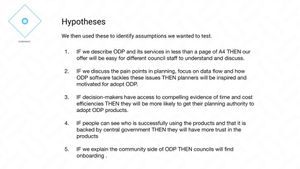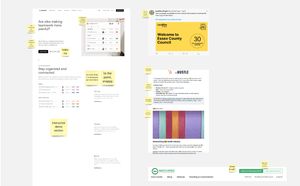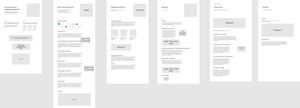ODP 2022 is a communications project run collaboratively between Lambeth Council, 11 other councils, DLUHC, Open Systems Lab, Unboxed and Agile Collective. The term ODP refers to Open Digital Planning, a planning programme for council officers, which includes various services and products that work towards digitally transforming the planning sector.
The Design phase is all about generating solutions for the key areas identified in the Definition stage, creating a prototype, user testing and iterating.
We used the following process during this mega design sprint on Open Digital Planning:
- Understand - Six interviews with current users whilst compiling ‘How Might We’ questions and creating a hypothesis.
- Sketch & Decide - Exploring different ideas to meet our goals and creating a storyboard to showcase the journey for new users.
- Prototype - Creating prototypes for the website, content and visual identity.
- Validate - Testing the website, content and visual identity with eight new users.
Goals
First, let’s revisit our goals for Open Digital Planning, the primary and secondary goals were agreed upon during the Definition Phase
- Attract new councils to join Open Digital Planning
- The programme has set an ambitious target for the number of councils it would like to have on board by April 2023. Our primary focus is providing communications to further this.
- The programme has set an ambitious target for the number of councils it would like to have on board by April 2023. Our primary focus is providing communications to further this.
- Support the Open Digital Planning team in their communications
- The programme team will be aligned under the new identity. Our secondary goal is to ensure partners feel proud of the brand and have assets that save them time in describing the programme and services.
Understand: Ask the Experts
In the design sprint model outlined above, our first step was to understand the existing user experience. We interviewed six people from councils using RIPA/BoPS (RIPA - Reducing Invalid Planning Applications, is a former name for applicant-facing Open Digital Planning software, BoPS refers to Back-office Planning System which is a council-facing case management system for planning officers to validate and process planning applications). Of this group, four were planners from councils in the South-East of the UK and two from the Open Digital Planning team.
Here are some anonymised quotes we captured during these sessions:
Frustrations with the planning processes:
“Hopefully planning would become more about planning, not the admin. A lot of time is wasted on admin instead of analysing proposals.”
Frustrations with planning software:
“The most difficult thing is having to use all the different systems.”
Read the full compilation of the quotes
How Might We…?
Based on insights from all six interviews, we formulated and prioritised the biggest communication challenges for Open digital Planning.
Here’s an example of how we framed and tackled a ‘How Might We’ question:
How might we demonstrate that Open Digital Planning will bring value?
The response to this question:
Emphasise a holistic approach to planning.
By improving integration (of data) we will reduce human error and increase efficiency.
By asking applicants the right questions, we are obtaining the right responses and improving the quality of applications received (and so reducing invalid applications).
But we have to find a way of explaining that the products may not yet do what they want.
Hypotheses
We then used our series of How Might We questions and responses to identify assumptions we wanted to test.

Ideation: Sketch & Decide
Before we could get stuck into sketching, we needed to look for inspiration to see what we liked/disliked about existing service websites. Steph and Rae completed a lightning demo, which involved looking for inspiration and making notes on what stood out to them.

We then compiled a list of everything we needed to prototype:
- Communication strategy
- Content
- Website structure
- Logo
- Visual design approach
- Clickable prototype in Figma
Our primary goal with the communications strategy was to introduce the project and catch planners attention! Enthuse them with social proof and evidence, engage them and finally delight them with a strong brand.
The greatest challenges we faced with content were:
- Deciding on which information to lead with
- Explaining that the offer is to be a contributing member of a community as much as it is software.
- Being clear that the software is constantly evolving and that it may not be a ready replacement for existing software.
Prototype
We decided the best way forward to tackle these challenges was to start wireframing and prototyping the website. This would help us identify what content was missing and allow us to review the existing content in context. We went through various iterations of lead content for the prototype. Once we were happy with the wording we sent out a Google form to test the lead content with all users that tested with us during the design phase and the existing Open Digital Planning community. In the end here’s what we came up with:
Slogan: Planning services designed by planners
Statement 1: We are a team of local government planners and officers rethinking local planning and co-designing new software. Together we are Open Digital Planning.
Statement 2: We are creating user-centred services that make applying for and assessing planning applications simpler for applicants, agents and council officers.
Whilst the content was being prepared, we started to create wireframes that would help envision what the prototype would look like and provide a sense of where specific content would live on the website.
Here’s what our wireframes looked like:

Once the wireframes were completed, we created a prototype of the website, ready for testing.
Test and reflect
We showed the website prototype to eight potential adopters of Open Digital Planning from a range of UK councils. We tested their comprehension of the offer, their enthusiasm for the programme and how they reacted to the website, the identity and the visual design.

Here’s what we concluded from the testing phase:
- The ODP offer appeals to all users we tested with. However, many of the users felt the decision was out of their hands.
- Whilst the language and the approach appealed to the testers, in general they did not understand the ODP offer from our short description.
- For people familiar with Uniform and other systems the offer of joining a community, raising funds and committing resources is wholly new.
- Once explained, users were generally enthusiastic about ODP, either in terms of the promises that ODP are making or in terms of identifying the main problem: too much admin. The involvement of other councils was key.
- Very positive about the look and feel of the design, which was considered smart, not too ‘public sector’ but not too ‘corporate’.
What's next?
Open Digital Planning follows the Agile process, which means the project is iterated along the way, allowing you to ‘release benefits throughout the process rather than only at the end’. The programme will continue to develop, with the input of the councils involved. It is not a finished product, rather an opportunity to get involved towards reaching an end goal. With a new identity across all channels and assets to inform new audiences and onboard interested councils, we’re confident that Open Digital Planning can reach their initial outlined goals.


